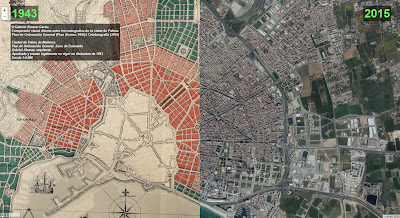https://dl.dropboxusercontent.com/u/ic_bcn_1859/index.htm
This time I have geo-rectified, warped and geo-referenced a historical plan of the city of Barcelona, signed by Idelfonso Cerdà in April 1859. It is the Plan of the Reform and Expansion Project, in which you can see the famous grid-style or right-angled layout planned by Cerdà, that organised the design of the streets into angles creating a network of parallel and perpendicular streets, and the characteristic chamfered squares of buildings. The Plan has been fitted in such a way that its correspondence with a 2015 orthophoto can be checked. Since I have used Leaflet to design this web-map, I have embedded a horizontal slider, which facilitates the scrolling of the comparison image with the recent orthophoto. The central coordinates of the web-map are (in decimal degrees): 41.404047, 2.187780. For the geo-rectification I used 8 control points scattered around your map, with an approximate error of 15.0. Although my geo-rectification is not very accurate, usually high error is caused by a single point being misreferenced. In any case, the overall result is acceptable.












